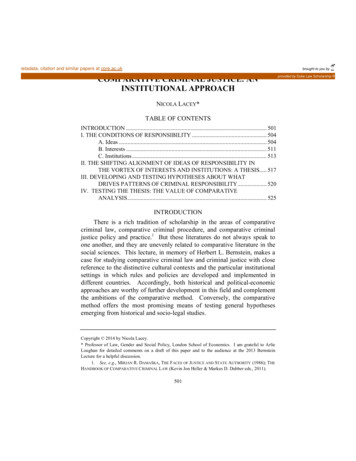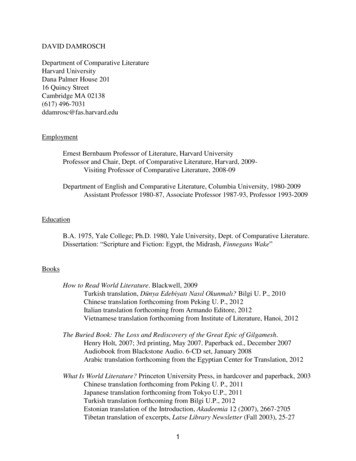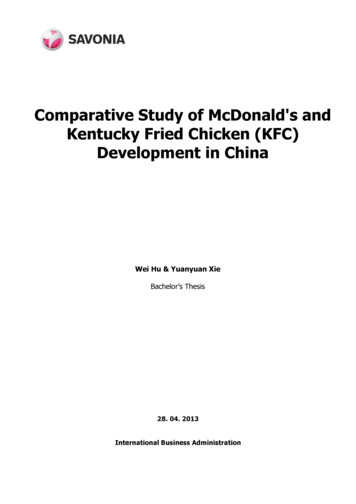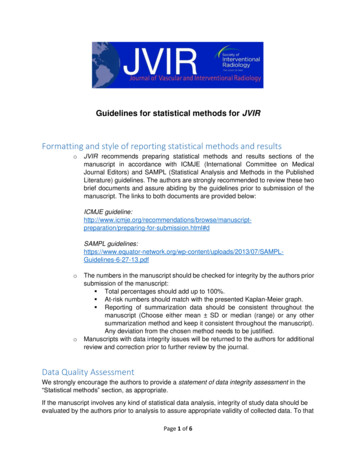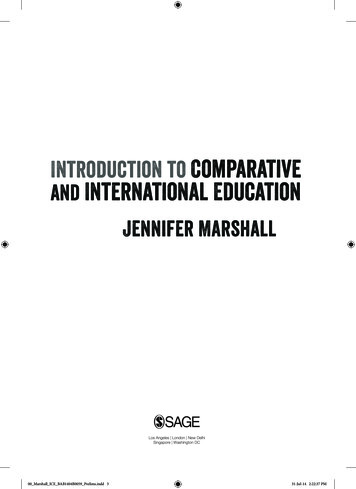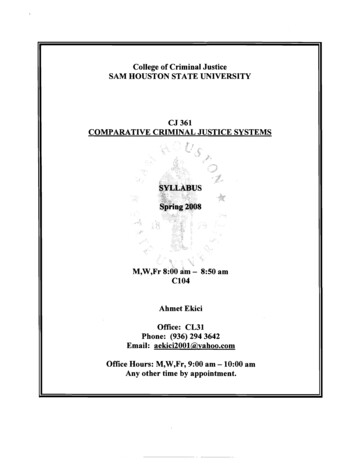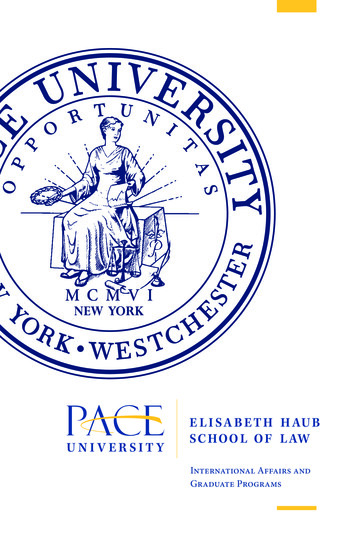
Transcription
View metadata, citation and similar papers at core.ac.ukbrought to you byCOREprovided by Digital Commons @ Butler UniversityJournal of Hindu-Christian StudiesVolume 29 God and Evil in Hindu and ChristianTheology, Myth, and PracticeArticle 82016Practice and the Comparative Study of Mysticism: The Yoga Sūtraand The Cloud of UnknowingGlenn YoungRockhurst UniversityFollow this and additional works at: https://digitalcommons.butler.edu/jhcsPart of the Catholic Studies Commons, Christianity Commons, Hindu Studies Commons, and theReligious Thought, Theology and Philosophy of Religion CommonsRecommended CitationYoung, Glenn (2016) "Practice and the Comparative Study of Mysticism: The Yoga Sūtra and The Cloud ofUnknowing," Journal of Hindu-Christian Studies: Vol. 29, Article 8.Available at: https://doi.org/10.7825/2164-6279.1631The Journal of Hindu-Christian Studies is a publication of the Society for Hindu-Christian Studies. The digitalversion is made available by Digital Commons @ Butler University. For questions about the Journal or the Society,please contact cbauman@butler.edu. For more information about Digital Commons @ Butler University, pleasecontact digitalscholarship@butler.edu.
Practice and the Comparative Study of Mysticism:The Yoga Sūtra and The Cloud of UnknowingGlenn YoungRockhurst UniversityIN his entry for the term “mysticism” in theupdated edition of the Encyclopedia of Religion,Peter Moore writes that “the varieties ofmystical practice tend to receive less scholarlyattention than the varieties of experience ordoctrine.”1 Bernard McGinn similarly claimsthat many studies of mysticism “so emphasizethe moment of mystical contact . . . that theyneglect the study of the fullness of the viamystica, particularly the ascetical and moralpreparation for such contact.”2 Following fromsuggestions such as these, this article will do acomparative reading of two mystical texts: theYoga Sūtra, a third-century Indian workattributed to Patañjali, and The Cloud ofUnknowing, an anonymous fourteenth-centuryEnglish treatise. Specifically, it will consider twodimensions of the mystical practices taught inthese texts. These are the taking of vows and thecontemplative stilling of the mind.To be sure, the Yoga Sūtra and The Cloud ofUnknowing are oriented to goals that areconceptualized in very different ways. The YogaSūtra is founded upon “a dualistic system thatpresupposes an ultimate and ” Following from this, the goal ofpractice is described as a liberation of thepractitioner’s consciousness from falseidentification with the material world, so that“the spirit stands in its true identity as observerJournal of Hindu-Christian Studies 29 (2016): 54-61to the world.”4 The Cloud of Unknowing is directedto consciousness of a God described intraditional Christian theistic terms as the one“who made you and bought you, and whograciously has called you to his love.”5Furthermore, as an apophatic text, the Cloudclaims that this consciousness is of a God who“may well be loved, but not thought.”6 Despitethe difference between these two texts, myconcern is with similar processes in the mysticalpractices they teach.By mystical practice, I mean, in the words ofMoore, “anything pertaining to the training ofbody and mind, whether as elements of amystic’s general way of life or as part of themore immediate conditions of the mysticalexperience.”7 An emphasis on practice isconsistent with the two texts being consideredhere, as can be seen in the characterizationsoffered by commentators on these texts. Forexample, Edwin Bryant describes the Yoga Sūtraas “primarily a manual for the practitionerrather than an exposition of Yoga philosophy.”8Similarly, McGinn suggests that the Cloud isdistinctive in “its combination of practicalspiritual advice and profound apophaticism.”9Because my concern is with practice, I willmake use of some concepts from performancetheory to interpret these texts. This theory isuseful because what these texts teach canindeed be understood as a performance; that is,
Practice and the Comparative Study of Mysticism 55they give their readers something to do, amystical practice to perform. In both the YogaSūtra and The Cloud of Unknowing, the taking ofvows constitutes a preliminary stage of mysticalpractice. Furthermore, both texts associatecontemplative stilling of the mind with theattainment of their respective goals, be thisrealization of one’s true nature or consciousnessof God. It may not be immediately apparent thatpractices such as these can be seen asperformance, given that they are largelyinternal rather than public phenomena. Yet, asGavin Flood claims with regard to asceticism(and I would suggest this can be extended tomysticism), even practices “performed withinthe privacy of a cell or forest are neverthelessstill public in the sense that they participate inand are given sanction by the wider communityand tradition.”10 Both vow taking andcontemplative stilling of the mind, the first andlast steps of mystical practice in the Yoga Sūtraand The Cloud of Unknowing, can be analyzed inthe terms of performance.Vow Taking as the Start of Mystical PracticeIn the Yoga Sūtra, practice is structuredaround a set of eight interrelated steps, whichare referred to as the eight limbs of yoga. Theseare “moral principles, observances, posture,breath control, withdrawal of the tion.” The first of these—moralprinciples—consists of the five behavioralguidelines of “nonviolence, truthfulness,abjuration of stealing, celibacy, and absence ofgreed.”12 Patañjali refers to these as “the greatvow of yoga.”13 It is especially important thatthis is the first of the eight limbs of yoga. Thissuggests the foundational role of the moralprinciples for the mystical practice as a whole.14This importance is further underscored byPatañjali’s insistence that the great vow is“universal” and “unrestricted by conditions ofbirth, place, time, or circumstance.”15 Thissuggests that the great vow cannot becompromised or altered based upon theparticularities of one’s social position.16 Theimplied contrast between one’s location insecular society and what is required for yogicpractice suggests an important aspect of thislimb of yoga, namely that adverting to the moralprinciples represents a turning away from theordinary circumstances of life. Furthermore, theparticular renunciations in the moral principlesserve to detach the practitioner fromassociation with the physical world. As such,they are consistent with the purpose of yoga. AsBryant explains, in yogic practice “one mustcurb activities that pander to the grosser urgesof the body—violence, stealing, deceit, sexualexploitation, and coveting are generallyperformed with a view to improving one’sbodily or material situation and must be resistedby one striving for transcendent goals.”17Of course, the practice of such vow takingcan be interpreted not only as withdrawal fromthe world, but also as movement toward moreauthentic and meaningful engagement with theworld. Such an interpretation is offered by IanWhicher, who claims that yoga practicereorients the way a person perceives the world,so that “one gains proper access to the worldand is therefore established in the rightrelationship to the world. Far from being deniedor renounced, the world, for the yogin, hasbecome transformed, properly engaged.”18Significantly, this perspective suggests thatwithdrawal from or engagement with the worldis not a simple binary opposition. According toWhicher, yoga practice “takes consciousness out
56 Glenn Youngof (ecstasis) its identification with the rigidstructure of the monadic ego, thereby reversingthe inveterate tendency of this ego to inflateitself at the expense of its responsibility inrelation to others.”19 Thus, by detaching fromthe way one ordinarily perceives oneself and theworld, one can relate more compassionatelywith that world. The particulars of the great vowserve to embody this new relationship betweenpractitioner and world.The foundational role of vow taking can alsobe seen in The Cloud of Unknowing. It must beacknowledged that consideration of this text isnecessarily more speculative, as the Cloud doesnot include explicit discussion of taking vows.Furthermore, since the Cloud was written by ananonymous author, it is difficult to know theprecise context in which the text was used. Thatbeing said, some things may be hypothesized. Inthe first chapter of the text, the Cloud authorstates that he is writing to a person living in the“singular” life, which is characterized by a“solitary form and manner of living.”20 Scholarsof the Cloud use textual clues such as this, alongwith historical considerations, to suggest thatthe Cloud is most likely monastic, and morespecifically, a text from the Carthusian order.21While this cannot be known with certainty, itseems evident that the text assumes awithdrawal from the world consistent with amonastic and even an eremitic form of life.Working from this assumption, some conclusionabout the vows that would form the context ofthe practice of this text can be addressed byconsidering the vows taken in Christianmonasticism.Initiation into the Carthusian order,following the more general tradition ofChristian monasticism set out in the Rule of St.Benedict, involves the taking of three vows:stability, which means remaining within one’smonastic community; obedience to the head ofthe monastery; and conversion of manners,which refers to the transformation of a worldlylifestyle to that of a monk.22 To address thesignificance of these vows, I will briefly draw onthe work of Thomas Merton, as this represents atraditional understanding of their role inChristian monastic life.Merton’s basic perspective is that “allreligious are by their very state obliged to acertain amount of separation from the world.”23 Ofcourse, this separation, which is embodied inthe vows taken by the monk, is understood toserve the purpose of developing a relationshipwith God: “The ascent to perfect charity isproportionate to detachment from all that is notGod.”24 As with the first limb of yoga, themystical practice associated with Christianmonasticism begins with vows that enact awithdrawal from identification with the world.This perspective on vows is two-fold. There isthe obvious opposition between the life of theworld and the life of the religious. Yet, this is inthe interest of the goal of the vows, union withGod. Detachment from the world corresponds toa union with God who is beyond the world. AsMerton says, “The fulfillment of our vow unitesus more perfectly with His will and His libertyand thereby takes us further beyond the sphereof the limited and the contingent. It takes us intothe sanctuary of His infinite love.”25It might be noted that the vows taken in theYoga Sūtra and those that constitute thebackground of The Cloud of Unknowing areconsiderably different from each other.26Nevertheless, the vows in these two traditionsdo something similar, even if they vary in theirparticular content. Both sets of vows enact aprocess of detachment from the world and
Practice and the Comparative Study of Mysticism 57ordinary circumstances of life. Through thisdetachment, the practitioner is brought into acondition of new consciousness. In the YogaSūtra, this involves realization of one’s truenature relative to the material world. In theChristian monastic context of the Cloud, thisinvolves awareness of God as ultimate reality.The particular perspective of performancetheory can be useful in addressing this. AsCatherine Bell explains, performance theoryfocuses “on what ritual actually does, ratherthan on what it is supposed to mean.”27 Whilethe specific content of the vows in these twotexts may be different, there is similarity inwhat taking these vows does as a part of mysticalpractice.The vow taking in the Yoga Sūtra and TheCloud of Unknowing can be interpreted with aconcept from performance theory referred to asframing. As its name suggests, framing concernsthe boundaries that are drawn around aperformance, so that its special and distinctivenature, relative to ordinary life, may beemphasized. It is, to use a theatrical metaphor, asetting of the stage, so that a performance maytake place. Mircea Eliade’s concept of sacredspace illustrates this framing. Eliade notes thatone aspect of spaces understood as sacred is thatthey have boundaries that serve to differentiatethem from the profane spaces that surroundthem. Such boundaries are key to their function.Thus, Eliade writes that a sacred space “is alwaysa clearly marked space which makes it possible . . to communicate with the sacred.”28 Eliadefurther suggests that the concept of sacredspace is applicable not only to physical locales;it can also refer to the metaphorical space at thecenter of one’s being, which is entered throughthe performance of a religious practice.29This framing can also function as apsychological process. Gregory Bateson explainsthat a frame is simultaneously exclusive andinclusive, in that it distinguishes what is outsidethe frame from what is inside. Furthermore, itsets up premises in the practitioner’s mind, sothat what is inside the frame is perceiveddifferently than what is outside it.30 I wouldsuggest that the vow taking in the Yoga Sūtra andThe Cloud of Unknowing functions as just such aframing device. It sets up a performative spacewithin which mystical consciousness can occur.It does this by excluding attachment to thephysical world and including a concern for whattranscends this. Writing about the great vow ofyoga, Eliade suggests that, by observing thisvow, “one creates new centers of experience.”31Similarly, referring to the vow of obedience, butapplicable to all the monastic vows, Mertonclaims, “We obtain, through the merit ofobedience, specific graces necessary to us asreligious, graces to do things in a monastic way,to see them from a monastic viewpoint, to attainto the kind of spiritual life and inner perfectionwhich is characteristic of a true monk.”32 Whatcan be noted in both these statements is the waytaking vows functions as a psychological framefor the practitioner. Understood in this way,these vows are a preliminary, but also crucial,aspect of mystical practice.Stilling the Mind as the End of Mystical PracticeHaving discussed vow taking as thebeginning of the paths set out in the Yoga Sūtraand The Cloud of Unknowing, the end point ofthese mystical practices can now be considered.Both texts associate mystical consciousnesswith a stilling of the mind, a transcendence ofordinary thought, and both texts giveinstruction in a practice to bring this about.
58 Glenn YoungThe Yoga Sūtra makes clear from its openinglines that the stilling of thought is the purposeof its practice: “This is the teaching of yoga.Yoga is the cessation of the turnings ofthought.”33 The final three limbs of on—are most specifically associatedwith this. Of the first of these, Patañjali statesthat “concentration is binding thought in oneplace.”34 According to Vyāsa’s commentary onthe Yoga Sūtra, the one place of concentrationcan include such things as “the circle of thenavel, the lotus in the heart, the light in thebrain, the tip of the nose, the tip of the tongue,or any external object as a place upon which themind can be fixed.”35 In addition, in moretheistically oriented Indian traditions, theobject of concentration can be the image ofone’s chosen deity.36 Whatever is concentratedupon, the essential element is fixing the mind onthat object. The next limb, meditation, is afurthering of this concentration. It is, in thewords of the Yoga Sūtra, the “focusing on a singleconceptual flow.”37 This is when the mind’sattention to the object of meditation becomes sofocused that it is undistracted by any othersense perception or thought.38 The final limb ofyoga, pure contemplation, is the culmination ofthis experience. Patañjali describes it as“meditation that illumines the object alone, as ifthe subject were devoid of intrinsic form.”39 Thekey characteristic of this final stage is that allsense of subject-object distinction istranscended. According to Bryant, “the mind isno longer aware of itself as meditating onsomething external to itself; all distinctions—between the yogi as the subjective meditator, theact of meditation, and the object of meditation—have disappeared.”40 At this point the turningsof thought have ceased; the goal of yogicpractice is reached.In The Cloud of Unknowing, the end point ofmystical practice can likewise be seen in termsof a stilling of the practitioner’s mind. This isoriented toward an experience in which God isthe only object present in one’s consciousness.The Cloud addresses this with one of its centralimages, the cloud of unknowing, which isdescribed as “a loving stirring and a blindbeholding unto the naked being of God himselfonly.”41 Such a consciousness of God is onlypossible if the practitioner detaches himselffrom awareness of everything other than God.Thoughts of anything else must be surpassed inwhat the author calls the cloud of forgetting.This includes thoughts about the createdworld,42 and even thoughts about devotionaltopics such as one’s sinfulness, the passion ofJesus, and the qualities of God.43 In short, for theCloud author, consciousness of God is onlypossible when consciousness of everythingother than God’s very self is forgotten. InMcGinn’s apt summary, this text describes a“dual exercise of forgetting created things andintending God in the cloud of unknowing.”44The Cloud author teaches a form ofcontemplativeprayerinwhichthepractitioner’s intent for God is encapsulated in asingle, short word. This word is the only thingsaid or thought in this prayer. He instructs hisreader:And if it pleases you have this intentwrapped and enfolded in one word, so thatyou should have a better hold thereupon,take but a little word of one syllable; for so itis better than of two, for ever the shorter itis, the better it accords with the work of thespirit. And such a word is this word GOD or
Practice and the Comparative Study of Mysticism 59this word LOVE. Choose which you will, oranother as it pleases you: whichever thatyou like best of one syllable. And fasten thisword to your heart, so that it never goesaway for anything that befalls you.45This single, short word serves a dualfunction in contemplative prayer. It both directsthe practitioner’s will toward encounter withGod in the cloud of unknowing; at the same time,it does this by functioning as a way to transcendall other thoughts, putting them beneath thecloud of forgetting. As the Cloud author explains,“With this word you shall beat on this cloud andthis darkness above you. With this word youshall smite down all manner of thought underthe cloud of forgetting; in so much that if anythought presses upon you to ask you what youwould have, answer him with no more words butwith this one word.”46Further explaining how this word functions,the Cloud author states that it “is prayed with afull spirit, in the height, and in the depth, and inthe length, and in the breadth of his spirit whoprays it.”47 The author then relates thisdescription of the word used in prayer to theGod to whom the prayer is directed: “Theeverlastingness of God is his length; his love ishis breadth; his might is his height; and hiswisdom is his depth. No wonder that a soul, thatis thus nearly conformed by grace to the imageand likeness of God, his maker, be soon heard ofGod.”48 The word thus sets up a correspondencebetween the entire being of the practitioner andthe entire being of God. While it may not beimmediately apparent, this description ofcontemplative prayer bears similarity to what isdescribed in the Yoga Sūtra. There, the final stageof meditative practice involves a loss ofdistinction between the meditator and theobject of meditation. While the Cloud might notgo so far as to claim erasure of distinctionbetween self and God, it does suggest that theform of practice embodies a union of thepractitioner with the object of his practice.As with the taking of vows, a concept fromperformance theory can help interpret thesecontemplative practices aimed at stilling themind. Richard Schechner explains that humanperformances are composed of what he callsrestored behavior, by which he means “physical,verbal, or virtual actions that are not-for-thefirst-time; that are prepared or rehearsed.”49Schechner explains that restored behavior “ismarked, framed, and separate”; it “can beworked on, stored and recalled, played with,made into something else, transmitted, andtransformed.”50 Furthermore, such behaviors“are freed from their original functions” in theway they are employed.51 This concept ofrestored behavior corresponds quite well withthe mystical practices being considered here. Inthe Yoga Sūtra, an object of meditation is madethe focus of consciousness. This object is cutloose from any ordinary meaning it might haveand used with the purpose of stilling the mind.In The Cloud of Unknowing, a single, short word isused to direct intention toward God andtranscend the thoughts ordinarily present in themind. Again, the associations of meaning thisword might ordinarily have are not nearly soimportant as is its function in contemplativeprayer.There is a final aspect of restored behaviorthat is important to consider here. Schechnersays it is ultimately the context of aperformance that gives a restored behavior theparticular significance it has.52 In discussing thetaking of vows, I suggested that this could beinterpreted with the concept of framing. Bell
60 Glenn Youngexplains that framing can refer to “the way inwhich some activities or messages set up aninterpretive framework within which tounderstand other subsequent or simultaneousacts or messages.”53 With this, I would suggestthat we are brought full circle, back to theconsideration of what happens at the outset ofthese mystical practices, and how this is relatedto the attainment of their respective goals. Vowtaking constructs a frame around theperformative space. It serves to detach one fromassociation with the physical world and profaneconsciousness. It likewise focuses awareness onwhat transcends this world, thereby moving onetoward sacred consciousness. In doing so, thisvow taking sets up a context within which therestored behavior of contemplative stilling ofthe mind can take place and have meaning.ConclusionThe scholar of mysticism Peter Moore writesthat “arguably, the varieties of mysticaltechnique offer a better point of entry to thecomparative study of mysticism than abstractontologies or phenomenologies.”54 What I havediscussed in this article has been an attempt toillustrate this claim. The Yoga Sūtra and The Cloudof Unknowing, different as they may be in termsof doctrinal assumptions underlying theirrespective experiences, and as different as thoseexperiences themselves may be, are similar inthe mystical practices they teach. Furthermore,interpreting these practices as performancescan explain how the taking of vows that markstheir beginning sets the stage for contemplativestilling of the mind that is their ions],” in Encyclopedia of Religion, 2nd ed.,ed. Lindsay Jones (Detroit: Macmillan Reference USA,2005), 6357.2Bernard McGinn, foreword to On the Kabbalahand Its Symbolism, by Gershom Scholem (New York:Schocken Books, 1996), xv.3Edwin F. Bryant, The Yoga Sūtras of Patañjali: ANew Edition, Translation, and Commentary; With Insightsfrom the Traditional Commentators (New York: NorthPoint Press, 2009), xlv.4Yoga Sūtra, 1.3. Barbara Stoler Miller, trans.,Yoga: Discipline of Freedom; The Yoga Sutra Attributed toPatanjali (New York: Bantam Books, 1995). Citations ofthe Yoga Sūtra are from this edition of the text.5The Cloud of Unknowing, 26/17-18. PhyllisHodgson, ed., The Cloud of Unknowing and The Book ofPrivy Counselling, Early English Text Society o.s. 218(London: /mdp.39015008395322Citations of the Cloud are from this edition of the text.Translations from the Middle English are my own.1Ibid., 26/4.Moore, “Mysticism [Further Considerations],”6357.8Bryant, Yoga Sūtras of Patañjali, lviii.9Bernard McGinn, The Varieties of VernacularMysticism (1350-1550), vol. 5 of The Presence of God: AHistory of Western Christian Mysticism (New York:Crossroad, 2012), 401.10Gavin Flood, The Ascetic Self: Subjectivity, Memoryand Tradition (Cambridge: Cambridge UniversityPress, 2004), 7.11Yoga Sūtra, 2.29.12Ibid., 2.30.13Ibid., 2.31.14Bryant, Yoga Sūtras of Patañjali, 243.15Yoga Sūtra, 2.31.16Bryant, Yoga Sūtras of Patañjali, 250.17Ibid., lviii.18Ian Whicher, “The Integration of Spirit (Puruṣa)and Matter (Prakṛti) in the Yoga Sūtra,” in Yoga: TheIndian Tradition, ed. Ian Whicher and David Carpenter(London: RoutledgeCurzon, 2003), 58.67
Practice and the Comparative Study of Mysticism 61Ibid., 60.20Cloud, 14/12-13.21On the possibility of Carthusian authorship ofthe Cloud, see James Walsh, introduction to The Cloudof Unknowing, The Classics of Western Spirituality(New York: Paulist Press, 1981), 2-9; John P.H. Clark,The Cloud of Unknowing: An Introduction, AnalectaCartusiana (Salzburg, Austria: Institut für Anglistikund Amerikanistik, Universität Salzburg, 1995), 1:1418.22E. Margaret Thompson, The Carthusian Order inEngland (London: Society for Promoting ChristianKnowledge, 1930), 32.23Thomas Merton, The Life of the Vows, vol. 6 ofInitiation into the Monastic Tradition, ed. Patrick F.O’Connell (Collegeville, MN: Liturgical Press, 2012),218.24Ibid., 116.25Ibid., 185.26Though poverty and chastity, which could beunderstood to correlate with the vows of absence ofgreed and celibacy in the Yoga Sūtra, are implied inChristian monastic vows. Columba Stewart, Prayerand Community: The Benedictine Tradition, Traditions ofChristian Spirituality (Maryknoll, NY: Orbis Books,1998), 92.27Catherine Bell, Ritual: Perspectives andDimensions (New York: Oxford University Press, 1997),73.28Mircea Eliade, Patterns in Comparative Religion,trans. Rosemary Sheed (1958; repr., Lincoln:University of Nebraska Press, 1996), 368.29Ibid., 382.19Gregory Bateson, Steps to an Ecology of the Mind(New York: Ballantine Books, 1972), 187-188.31Mircea Eliade, Yoga: Immortality and Freedom,2nd ed., trans. Willard R. Trask (Princeton, .org/2027/mdp.3907600528045332Merton, Life of the Vows, 238.33Yoga Sūtra, 1.1-1.2.34Ibid., 3.1.35Bryant, Yoga Sūtras of Patañjali, 302.36Ibid.37Yoga Sūtra, 3.2.38Bryant, Yoga Sūtras of Patañjali, 303.39Yoga Sūtra, 3.3.40Bryant, Yoga Sūtras of Patañjali, 307.41Cloud, 32/7-8.42Ibid., 24/1-4.43Ibid., 27/15-28/2.44McGinn, Varieties of Vernacular Mysticism, 404.45Cloud, 28/10-16.46Ibid., 28/18-29/1.47Ibid., 75/7-8.48Ibid., 75/17-21.49Richard Schechner, Performance Studies: AnIntroduction, 3rd ed. (London: Routledge, 2013), 29.50Ibid., 35.51Ibid., 65. Schechner is describing ritual activitymore generally here, which he says is similar torestored behavior.52Ibid., 30.53Bell, Ritual, 74.54Moore, “Mysticism [Further Considerations],”6357-6358.30
The Cloud of Unknowing, an anonymous fourteenth-century English treatise. Specifically, it will consider two dimensions of the mystical practices taught in these texts. These are the taking of vows and the contemplative stilling of the mind. To be sure, the . Yoga . Sūtra and . The Cloud of Unknowing. are oriented to goals that are


